The search model that Google brought to the web does not really work on mobile – mobile is both ‘post-Netscape’ and ‘post-Pagerank’
/2014/12/08/the-search-model-that-google-brought-to-the-web/
Writing online
The search model that Google brought to the web does not really work on mobile – mobile is both ‘post-Netscape’ and ‘post-Pagerank’
/2014/12/08/the-search-model-that-google-brought-to-the-web/
iTunes connect updated today with better numbers regarding Public Art downloads.
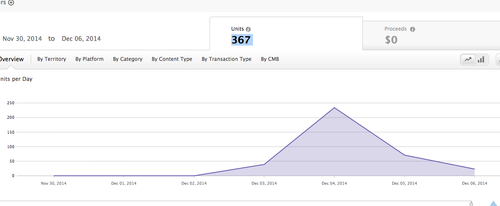
The total download count to date is 367.
The prelaunch day had 39 downloads from mailchimp and twitter.
The peak download day had 234 downloads, primarily from Product Hunt and Laughing Squid.

The percentage of push notification accepted per overall downloads were much higher on the second day. First day was 37.6%. Second day was 43%.
Push notifications were accepted on 175 devices (appox 47.6%).
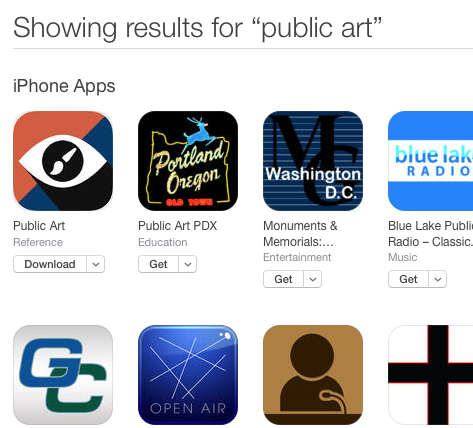
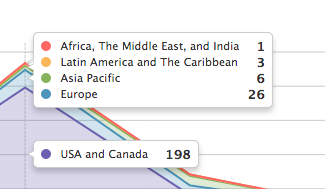
The regions breakdown for downloads is: USA, followed by Europe, Asia, Latin America, and Africa.
Public Art was downloaded in 22 countries: US, Canada, UK, Germany, Netherlands, France, Italy, Sweden, Norway, Russia, Spain, Switzerland, Japan, Australia, China, Hong Kong, Taiwan, Indonesia, Brazil, Mexico, Argentina, and India.

My photography professor said that my coffee pictures were boring so I decided to step it up a notch

My photography professor said that my coffee pictures were boring so I decided to step it up a notch
/2014/12/08/rachelbeee-my-photography-professor-said-that-2/


The primary function of my app is to check your current location against a database of geotagged images. This is a straightforward call that leans on a ruby gem called Geocoder. To translate the user’s current location, I grab the longitude and latitude of a user, then use Google Maps Geocoder API to translate the coordinates into usable data.
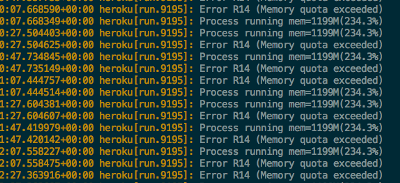
I was unprepared for the Google Maps Geocoder api quota. At midnight, I noticed that my server wasn’t returning queries to users because Google Maps quota had expired. This could have been incredibly frustrating if the logic for the query was in the iOS app. Fortunately, the query was made through the Rails application I setup as an API endpoint. I was able to make adjustments to the Geocoder source and spin up a Data Science Toolkit virtual machine on a AWS box. I switched the API endpoints to the DSTK and got the Geocodes back up and running.

Last night, after noticing the Google Maps api quota was maxed out, I tried to find a way to communicate to any users who were receiving empty queries. I intended to send an in-app notification to anyone currently on the app. In the process, I accidentally sent all app downloads a push notification. This was right at midnight on the east coast, so I felt very bad for any people who may have been disturbed. If it was me, I’d be pissed.
I spent days of continuous work to figure out how to get the correct assets, prepare my build files, get the right version of ode installed, etc. The week before Thanks Giving, I was on the subway home from Brooklyn and editing the promo video for the app on Photoshop. Anything that can help accelerate the process is helpful.
A huge help were all the Sketch.app plugins that helped generate in-app and app store assets.
The lean startup approach is all about doing as much work as needed for getting core functionality, without making assumptions about your user’s taste. In this way, you use data to gain insights on what needs to be further developed. To do this correctly, you need to have a good analytics framework setup.
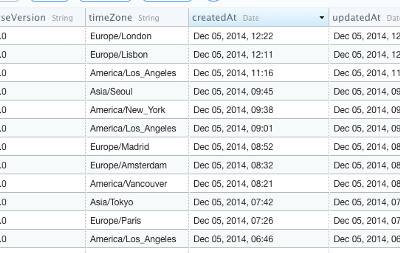
I spent time setting up event tracking on my app, but completely missed some obvious things. The main pitfall was that I didnt set up a user definition attribute. I accounted for the events that would help me track user frustration, but Im not able to do any effective user segmenting. Its hard for me to isolate the data trails to specific users.
I also leaned on two analytics services because I couldnt get one to fulfill all my needs. I used Mixpanel for event tracking and Parse for push notification management. In the process, I didnt fully set up Parse correctly and never integrated user profiles into Mixpanel. The partial setup handicaps me from knowing the user response to push notifications or segmenting data by users.
I set up enough tracking to generate a solid list of events. I find when people query, where they query from, how they click, what they click, how many searched they do, etc. Now that I have this data, I dont have any inherit insights. I need to go back to each event and understand exactly how it is generated. I have some events that were called hundreds of times and others that were called only 10 or 20 times. Differentiating how the event may be set up incorrectly, or how there is a huge demand for a certain action is hard.

One thing that I wish I had was a basic events list for user actions that are not in my app. For example, I want to know if people tried to swipe left or right, pinched, rotate their device. I didnt try to capture these events but it would be useful for understanding how to develop future features.
Im still not sure what the actual total downloads or user actions were. iTunes, Mixpanel and Parse are all out of sync. Ironically, I trust Parse more than iTunes because it reports unique device parameters that I can see.
Overall, the process was a success. Most importantly, I feel good about the process. I was excited to see Laughing Squid post about the app and Product Hunt attention.
If you haven’t already, check out Public Art. The app to discover graffiti and street art near you!
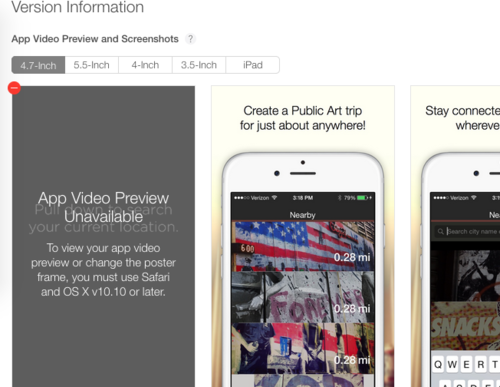
1. Launching on the Apple store is time consuming.
I spent days of continuous work to figure out how to get the correct assets, prepare my build files, get the right version of xcode installed, etc. Anything that can help accelerate the process is helpful.
A huge help were Sketch.app plugins that helped generate in-app and app store assets. http://sketchtoappstore.com/
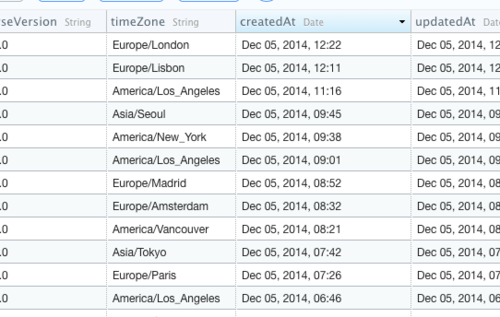
2. Setting up analytics is hard
The lean startup approach is all about doing as much work as needed for getting core functionality, without making assumptions about your user’s taste. In this way, you use data to gain insights on what needs to be further developed. To do this correctly, you need to have a good analytics framework setup.
I spent time setting up event tracking on my app, but completely missed some obvious things. The main pitfall was that I didnt set up a user definition attribute. I accounted for the events that would help me track user frustration, but Im not able to do any effective user segmenting. Its hard for me to isolate the data trails to specific users.
I also leaned on two analytics services because I couldnt get one to fulfill all my needs. I used Mixpanel for event tracking and Parse for push notification management. In the process, I didnt fully set up Parse correctly and never integrated user profiles into Mixpanel. The partial setup handicaps me from knowing the user response to push notifications or segmenting data by users.

3. Understanding analytics is also hard
I set up enough tracking to generate a solid list of events. I find when people query, where they query from, how they click, what they click, how many searched they do, etc. Now that I have this data, I dont have any inherit insights. I need to go back to each event and understand exactly how it is generated. I have some events that were called hundreds of times and others that were called only 10 or 20 times. Differentiating how the event may be set up incorrectly, or how there is a huge demand for a certain action is hard.
One thing that I wish I had was a basic events list for user actions that are not in my app. For example, I want to know if people tried to swipe left or right, pinched, rotate their device. I didnt try to capture these events but it would be useful for understanding how to develop future features.
Im still not sure what the actual total downloads or user actions were. iTunes, Mixpanel and Parse are all out of sync. Ironically, I trust Parse more than iTunes because it reports unique device parameters that I can see.
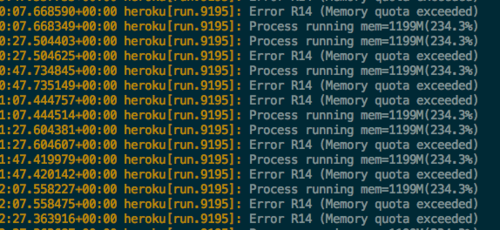
4. Having control of the external services is important
The primary function of my app is to check your current location against a database of geotagged images. This is a straightforward call that leans on a ruby gem called Geocoder. To translate the user’s current location, I grab the longitude and latitude of a user, then use Google Maps geocoder API to translate the coordinates into usable data.
I was unprepared for the Google Maps geocoder api quota. At midnight, I noticed that my server wasn’t returning queries to users because Google Maps quota had expired. This could have been incredibly frustrating if the logic for the query was in the iOS app. Fortunately, the query was made through the Rails application I setup as an API endpoint. I was able to make adjustments to the Geocoder source and spin up a Data Science Toolkit virtual machine on a AWS box. I switched the API endpoints to the DSTK and got the Geocodes back up and running.

5. Misusing app push notifications is very easy
Last night, after noticing the Google Maps api quota was maxed out, I tried to find a way to communicate to any users who were receiving empty queries. I intended to send an in-app notification to anyone currently on the app. In the process, I accidentally sent all app downloads a push notification. This was right at midnight on the east coast, so I felt very bad for any people who may have been disturbed. If it was me, I’d be pissed.
–
Overall, the process was a success. Most importantly, I feel good about the process. I was excited to see Laughing Squid post about the app and the traction it received on Product Hunt.
If you haven’t already, check out Public Art. The app to discover graffiti and street art near you!